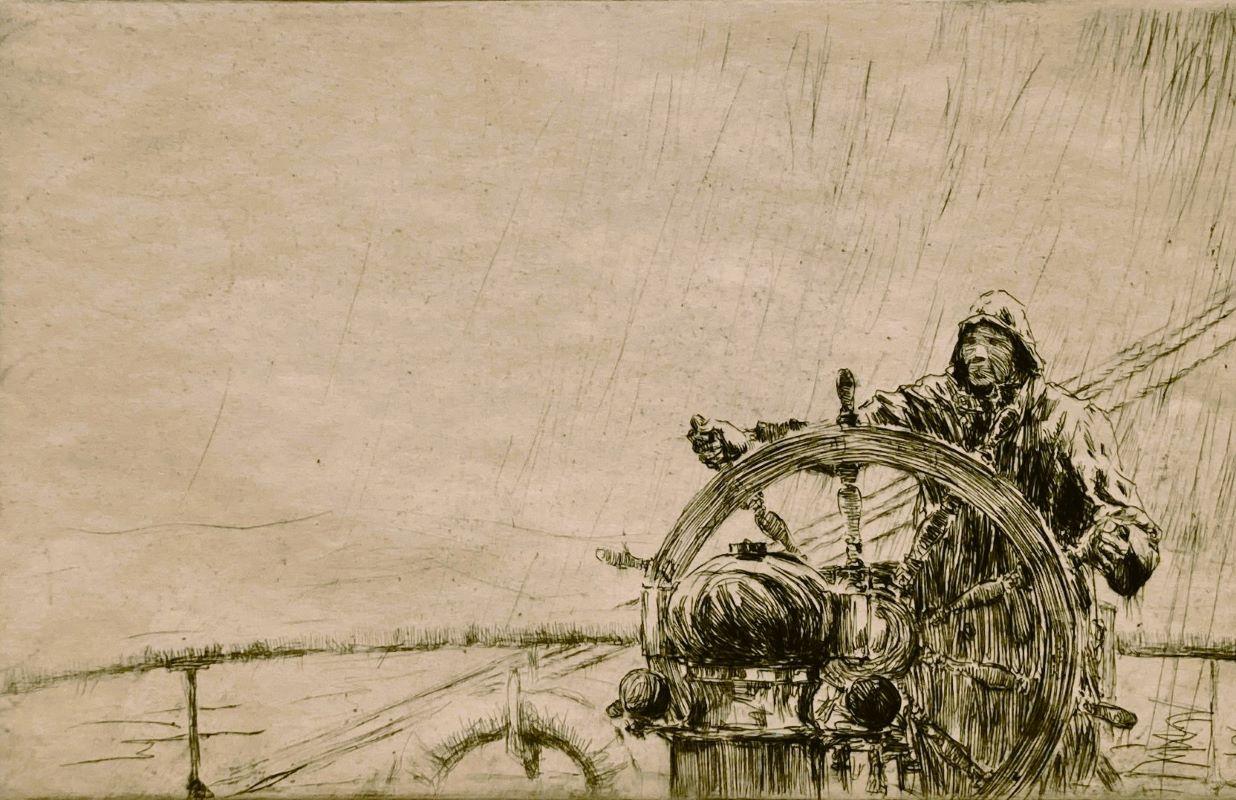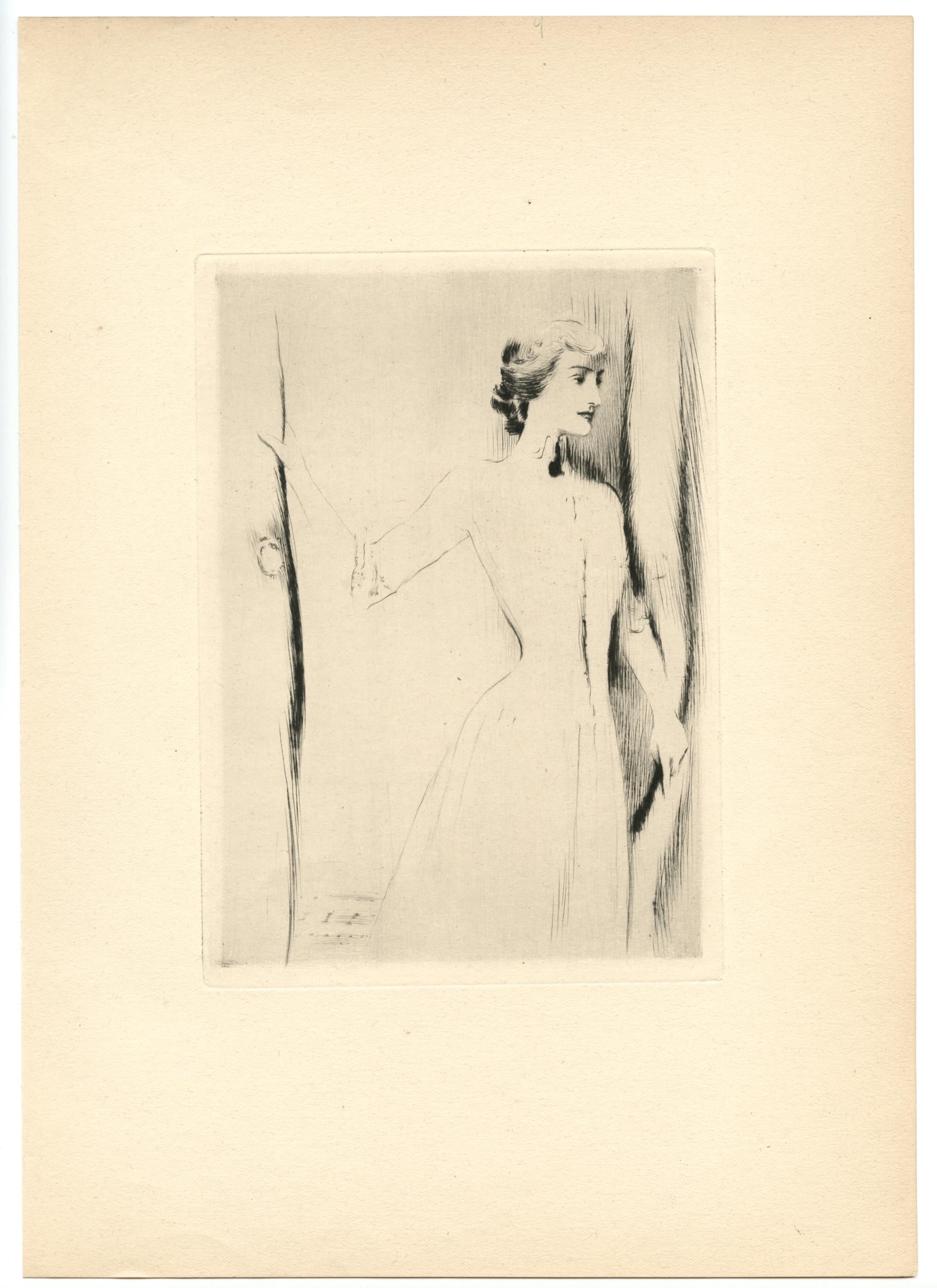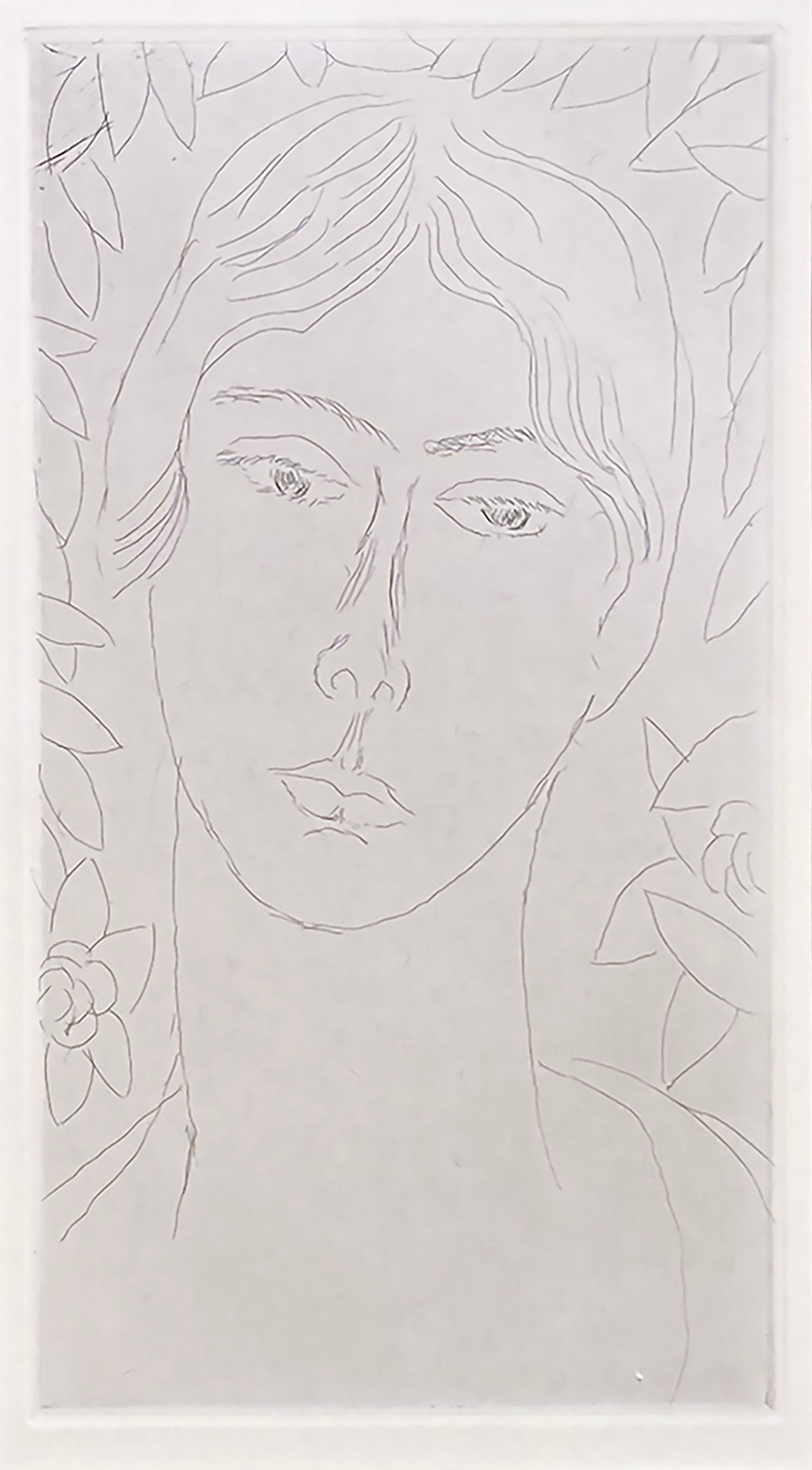Items Similar to "La Mere de Whistler, " an Etching and Drypoint signed by Auguste Brouet
Want more images or videos?
Request additional images or videos from the seller
1 of 9
Auguste Brouet"La Mere de Whistler, " an Etching and Drypoint signed by Auguste Brouetc. 1900-1910
c. 1900-1910
About the Item
"La Mere de Whistler" is an original etching and drypoint signed by the French artist Auguste Brouet in the lower right. It depicts famous artist James Abbott McNeill Whistler's mother.
9 3/4" x 7" art
21 3/4" x 19" frame
Auguste Brouet (1872–1941) was a French etcher and book illustrator.
Auguste Brouet was born and raised in a poor family in the popular north-east quarters of Paris and in Les Lilas, in the near suburbs. While apprenticed to a lithographer, he struggled for artistic education through the evening drawing classes of Eugène Quignolot (1858-1918), also briefly attending Gustave Moreau's atelier. Starting from around 1895 he would make a living by doing hack work for fashionable artists and also crafting reproductive etchings in color, in the workshop of Eugène Delâtre. Around 1902 he started to devise original etchings, sometimes larger pieces in color, more often smaller works in black and white, as was the growing trend at the time.
In the 1920s, his etchings came under strong demand both in France and in the United States, in the wake of the Print Revival. At that time, he also produced a significant body of book illustrations, most notably for Devambez, under the direction of Edouard Chimot. This period of prosperity ends with the Great Depression, from which the print market never quite recovered. Brouet died in 1941 in poverty.
The art of Auguste Brouet belongs to the classical tradition. Brouet remained almost completely impervious to the modernist trends developing at the time. There are two characteristics which make a Brouet etching unmistakable: a certain expressive looseness of the drawing, which in his best work blends magnificently with his use of light and shades and a very keen and sympathetic eye for all the lower social categories, their daily activities and shabby surroundings. Even his war subjects display this inner restraint and brooding mood which are so distinctive of his work.
- Creator:Auguste Brouet (1872-1941, French)
- Creation Year:c. 1900-1910
- Dimensions:Height: 21.75 in (55.25 cm)Width: 19 in (48.26 cm)
- Medium:
- Period:
- Condition:
- Gallery Location:Milwaukee, WI
- Reference Number:
About the Seller
4.9
Platinum Seller
These expertly vetted sellers are 1stDibs' most experienced sellers and are rated highest by our customers.
Established in 1966
1stDibs seller since 2017
388 sales on 1stDibs
Typical response time: 1 hour
- ShippingRetrieving quote...Ships From: Milwaukee, WI
- Return PolicyA return for this item may be initiated within 14 days of delivery.
More From This SellerView All
- "Mes Petites Amies, Les Deux Sœurs" signed by Jacques VillonBy Jacques VillonLocated in Milwaukee, WIThis is an original drypoint and aquatint artwork by Jacques Villon. The artist signed in pencil on the lower right. As well as signed in plate at the top right of the image. This is a wonderful artwork of different intaglio processes being brought together in a beautiful almost seamless harmony. The thin pencil like markings and hair detailing are made using the Drypoint printmaking method. Whilst the color details around the girls are made using the Aquatint etching method. Jacques Villon shows his skills as a printmaker with the way these pieces line up perfectly and with how clean the rest of the plate is around the girls. Catalogue Raisonne E101, pg. 66-67 (Ginestet & Pouillon. It depicts two young girls. 15" x 11 1/2" art 25 1/8" x 20" frame French painter, printmaker and illustrator. The oldest of three brothers who became major 20th-century artists, including Raymond Duchamp-Villon and Marcel Duchamp, he learnt engraving at the age of 16 from his maternal grandfather, Emile-Frédéric Nicolle (1830-94), a ship-broker who was also a much appreciated amateur artist. In January 1894, having completed his studies at the Lycée Corneille in Rouen, he was sent to study at the Faculty of Law of the University of Paris, but within a year he was devoting most of his time to art, already contributing lithographs to Parisian illustrated newspapers such as Assiette au beurre. At this time he chose his pseudonym: Jack (subsequently Jacques) in homage to Alphonse Daudet’s novel Jack (1876) and Villon in appreciation of the 15th-century French poet François Villon...Category
Early 1900s Modern Figurative Prints
MaterialsDrypoint, Aquatint, Etching, Intaglio
- Portrait of a Man an Engraving by Wenceslaus HollarBy Wenceslaus HollarLocated in Milwaukee, WI"Portrait of a Man" is an engraving after Hans Holbein by Wenceslaus von Prochna Hollar. It depicts a man in traditional dress for the mid-17th century: A flat hat, large shirt, and ...Category
Mid-17th Century Old Masters Portrait Prints
MaterialsEngraving
- 'Portrait of Henrico van der Borcht, ' original W. Hollar engraving after HolbeinBy Wenceslaus HollarLocated in Milwaukee, WIIn this print, Wenceslaus Hollar presents a portrait of D. Henrico van der Borcht, copying a painting or drawing by Hans Holbein. Copying works of famous masters was a common task of...Category
17th Century Old Masters Portrait Prints
MaterialsEngraving
- 'Portrait of M. Morett, ' original Wenceslaus Hollar engraving after Hans HolbeinBy Wenceslaus HollarLocated in Milwaukee, WIIn this print, Wenceslaus Hollar presents a portrait of Charles de Solier, comte de Morette, copying a painting and a drawing by Hans Holbein the Younger - both of which are kept in ...Category
17th Century Old Masters Portrait Prints
MaterialsEngraving
- 'Portrait of a Young Woman' original Hollar engraving after Hans HolbeinBy Wenceslaus HollarLocated in Milwaukee, WIIn this print, Wenceslaus Hollar presents a portrait of an unidentified woman, copying a portrait by Hans Holbein the Younger. The identity of the sitter is a mystery: formerly, the portrait was believed to be of Catherine of Aragon, and the National Portrait Gallery in London identifies her as Queen Mary I...Category
17th Century Old Masters Portrait Prints
MaterialsEngraving
- 'Peter Breughel' Original Etching, Signed in PencilBy Leonard BaskinLocated in Milwaukee, WIThe present artwork is an original etching by American artist Leonard Baskin. Here, he presents a portrait of the Flemish Renaissance artist Peter Breughel the Elder in profile, executed after the engraving by Johannes Wierix published in 1572 by Volcxken Diericx and Hieronymus Cock. In the portrait, Baskin displays a love of line and texture, using the etching technique to exaggerate and draw attention to the wrinkles of the face, while leaving the hair and clothing like a study or sketch. Like in the work of contemporary artist Claude Weisbuch, the result for Baskin is an image that recalls the old masters and displays the mastery of contemporary printmakers, but that also places mid-century formal concerns at the forefront of portraiture and figuration. etching in black in on Rives paper 17.5 x 17.5 inches, plate 29.75 x 22 inches, sheet 33.5 x 25.88 inches, frame Entitled "Breughel" in pencil, lower left Edition 9/50 in pencil, lower center Signed in pencil, lower right "PB" in the plate, upper left "PB" in the plate, upper right (faint) Label for Irving Galleries, Milwaukee on reverse Label for David Barnett Gallery on reverse Framed behind glass in a distressed cassetta-style moulding Artwork in overall good condition; general toning to the paper; some scattered foxing; frame in good condition with some losses to finished surface revealing white ground Born in 1922 in New Brunswick, New Jersey, Baskin was reared in Brooklyn, New York. The son of a Rabbi, Baskin was educated at a yeshiva (Jewish religious college), which had a profound effect on his aesthetic. Committed to art at an early age, Baskin had his first exhibition. of sculpture, at the Glickman Studio Gallery, New York, at the age of seventeen. He studied at Yale University from 1941 to 1943 and received his B.A. at the New School for Social Research in 1949. Baskin spent 1950 and 1951 abroad, studying in Paris and Florence. In 1953 he began teaching printmaking and sculpture at Smith College in Northampton, Massachusetts, where he remained until 1974. It was while he was at Smith College that he founded Gehenna Press, a small private press specializing in fine book production. He moved to England in 1974 and stayed till 1983 when he returned to America.. These nine years were enormously productive and besides sculptures he created a fine selection of prints and paintings. Baskin became intrigued by Greek history, philosophy and mythology at an early age and this study inspired many of his sculptures and paintings. Other influences were early 20th century sculptors, notably Ernst Barlach Leonard Baskin was one of the universal artists of the 20th century. He was a sculptor of renown. He was a writer and illustrator of books ranging from the bible to children's' stories and natural history. He was a talented water-colourist and a superb, prolific print-maker. His prints ranged from woodcuts through lithography and etching; his subjects covered portraits...Category
1960s Old Masters Portrait Prints
MaterialsPaper, Etching
You May Also Like
- Olliver St. John GogartyBy Gerald Leslie BrockhurstLocated in Storrs, CTOliver St. John Gogarty. 1935. Etching. Fletcher 78. 6 7/8 x 5 1/2 (sheet 11 1/4 x 8 3/8). Edition 100. 75 intended for the Cuala Press, Dublin. A rich impression, printed on cream-...Category
Mid-20th Century Modern Portrait Prints
MaterialsDrypoint, Etching
- The HelmsmanBy Arthur John Trevor BriscoeLocated in Storrs, CTThe Helmsman. 1925. Etching. Hurst 130. 7 x 10 7/8 (sheet 11 x 5). Trial proof, apart from the edition of 75 An extremely rich impression printed cream wove paper. An exceptionally r...Category
1920s Modern Landscape Prints
MaterialsDrypoint, Etching
- "Un rideau" original drypointBy Fernand KhnopffLocated in Henderson, NVMedium: original etching and drypoint. This impression on wove paper was printed in 1904 and published in Paris by the Revue de l'Art ancien et moderne. Plate size: 6 5/8 x 4 3/4 inc...Category
Early 1900s Portrait Prints
MaterialsDrypoint, Etching
- My DaughterLocated in Middletown, NYDrypoint etching on buff wove paper, 9 3/4 x 12 3/4 inches (250 x 322 mm), full margins. Signed in pencil, lower right margin. Some general age tone, and minor mat tone around the pe...Category
Early 20th Century Modern Portrait Prints
MaterialsEtching, Drypoint
- Bibi ValentinBy James Abbott McNeill WhistlerLocated in Storrs, CTBibi Valentin. 1859. Etching and drypoint. Kennedy catalog 50 state ii; Glasgow catalog 34 state ii. 6 x 8 7/8 (sheet 8 11/16 x 10 11/16). Glasgow records 44 known impressions. A rich impression with burr, printed on watermarked laid paper with full margins. Signed and dated in the plate. Housed in a 20 x 16-inch archival mat A young girl, sits facing the viewer, leaning on her left elbow, legs extended to left. She wears a high-necked smock and buttoned boots...Category
19th Century American Modern Portrait Prints
MaterialsEtching, Drypoint
- "Mlle Landsberg" (grade planche, pl. 16)By Henri MatisseLocated in Missouri, MO"Mlle Landsberg" (grade planche, pl. 16), 1914 Henri Matisse (French, 1869-1954) Signed and Numbered Lower Right Edition 12/15 Image size: 7 7/8 x 4 5/16 inches Sheet size: 17 11/16 x 12 1/2 inches With frame: 19 1/2 x 14 1/2 inches Henri Matisse came from a family who were of Flemish origin and lived near the Belgian border. At eight o'clock on the evening of December 31, 1869, he was born in his grandparents' home in the town of Le Cateau in the cheerless far north of France. His father was a self-made seed merchant who was a mixture of determination and tightly coiled tension. Henri had no clear idea of what he wanted to do with his life. He was a twenty-year-old law clerk convalescing from appendicitis when he first began to paint, using a box of colors given to him by his mother. Little more than a year later, in 1890, he had abandoned law and was studying art in Paris. The classes consisted of drawing from plaster casts and nude models and of copying paintings in the Louvre. He soon rebelled against the school's conservative atmosphere; he replaced the dark tones of his earliest works with brighter colors that reflected his awareness of Impressionism. Matisse was also a violinist; he took an odd pride in the notion that if his painting eye failed, he could support his family by fiddling on the streets of Paris. Henri found a girlfriend while studying art, and he fathered a daughter, Marguerite, by her in 1894. In 1898 he married another woman, Amelie Parayre. She adopted the beloved Marguerite; they eventually had two sons, Jean, a sculptor and Pierre who became an eminent art dealer. Relations between Matisse and his wife were often strained. He often dallied with other women, and they finally separated in 1939 over a model who had been hired as a companion for Mme. Matisse. She was Madame Lydia, and after Mme. Matisse left, she remained with Matisse until he died. Matisse spent the summer of 1905 working with Andre Derain in the small Mediterranean seaport of Collioure. They began using bright and dissonant colors. When they and their colleagues exhibited together, they caused a sensation. The critics and the public considered their paintings to be so crude and so roughly crafted that the group became known as Les Fauves (the wild beasts). By 1907, Matisse moved on from the concerns of Fauvism and turned his attention to studies of the human figure. He had begun to sculpt a few years earlier. In 1910, when he saw an exhibition of Islamic art, he was fascinated with the multiple patterned areas and adapted the decorative universe of the miniatures to his interiors. As a continuation of his interest in the "exotic", Matisse made extended trips to Morocco in 1912 and 1913. At the end of 1917, Matisse moved to Nice; he would spend part of each year there for the remainder of his life. A meticulous dandy, he wore a light tweed jacket amd a tie when he painted. He never used a palette, but instead squeezed his colors on to plain white kitchen dishes...Category
1910s Fauvist Figurative Prints
MaterialsEtching, Drypoint
Recently Viewed
View AllMore Ways To Browse
French Auguste
Auguste French
1902 Portraits
James A Mcneill Whistler
Gustave Le Gray
Etchings By Whistler
Whistler Original Print
Whistler Lithograph
A Moreau 3
Moreau Book
20th Century Quarters
Auguste Moreau Original
Whistler Drypoint
James Whistler Lithograph
James Abbott Mcneill Whistler Etching
Whistlers Mother
Auguste Delatre
Eugene Delatre




